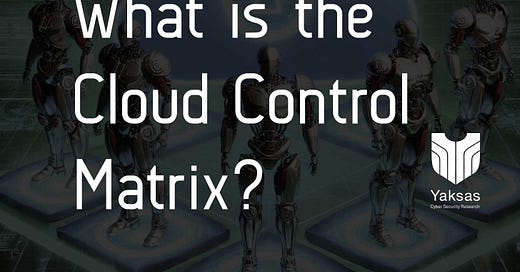What is the Cloud Control Matrix (CCM)?
The Cloud Control Matrix (CCM) is a cybersecurity control framework for cloud computing, developed by the Cloud Security Alliance (CSA).
The Cloud Control Matrix (CCM) is a cybersecurity control framework for cloud computing, developed by the Cloud Security Alliance (CSA). It is designed to provide fundamental security principles to guide cloud vendors and assist prospective cloud customers in assessing the overall security risk of a cloud provider. The CCM addresses various aspects of cloud technology, including security, privacy, and regulatory compliance.
Key Features of the Cloud Control Matrix
Comprehensive Coverage: The CCM covers a broad range of security domains, encompassing 133 control objectives structured across 16 domains. These domains include Application & Interface Security (AIS), Audit Assurance & Compliance (AAC), Business Continuity Management & Operational Resilience (BCR), and many others. Each domain provides specific guidelines to ensure the integrity, confidentiality, and availability of data and cloud services.
Alignment with Industry Standards: The CCM is aligned with major industry standards, frameworks, and regulations such as ISO/IEC 27001/27002, NIST SP 800-53, and the GDPR. This alignment ensures that organizations leveraging the CCM can achieve compliance with multiple regulatory requirements more efficiently, reducing the complexity and costs associated with compliance efforts.
Risk Management: By adopting the CCM, organizations can enhance their risk management strategies. The matrix provides a structured approach to identifying, assessing, and managing risks associated with cloud computing. It helps in performing risk assessments and implementing appropriate controls to mitigate identified risks.
Shared Responsibility Model: One of the fundamental concepts in the CCM is the shared responsibility model. It delineates the division of security responsibilities between Cloud Service Providers (CSPs) and cloud customers. This model helps both parties understand their respective roles in ensuring the security of cloud environments, promoting better collaboration and risk mitigation.
Enhancing Cloud Security Posture: The CCM aids organizations in evaluating the security posture of cloud providers. By leveraging the control objectives, customers can assess whether a cloud provider meets their security requirements and standards. This evaluation helps in making informed decisions when selecting cloud service providers and enhances overall cloud security.
Continuous Improvement: The CCM is designed to be dynamic, with periodic updates reflecting the latest advancements and threats in cloud security. This ensures that the framework remains relevant and effective in addressing emerging security challenges. Organizations can continuously improve their security practices by staying updated with the latest versions of the CCM.
Practical Applications
Vendor Risk Management: Organizations can use the CCM to assess and manage the risks associated with third-party cloud service providers. It provides a standardized approach to evaluate the security controls implemented by vendors, ensuring they meet the organization's security requirements.
Regulatory Compliance: The CCM helps organizations achieve and maintain compliance with various regulatory requirements. By mapping the control objectives to specific regulations, organizations can streamline their compliance efforts and demonstrate adherence to regulatory standards.
Security Audits: The CCM can be used as a framework for conducting security audits. Auditors can leverage the control objectives to evaluate the effectiveness of security controls implemented by the organization, identify gaps, and recommend improvements.
Conclusion
The Cloud Control Matrix is an essential tool for organizations leveraging cloud services. It provides a comprehensive framework for implementing robust security controls, ensuring compliance with industry standards, and effectively managing risks. By adopting the CCM, organizations can enhance their cloud security posture, mitigate risks, and achieve greater confidence in their cloud computing environments.
For more detailed information and access to the CCM, visit the Cloud Security Alliance website: Cloud Security Alliance - Cloud Control Matrix.
Join the discussion on Discord or WhatsApp (Yaksas Cybersecurity Infoshare).



